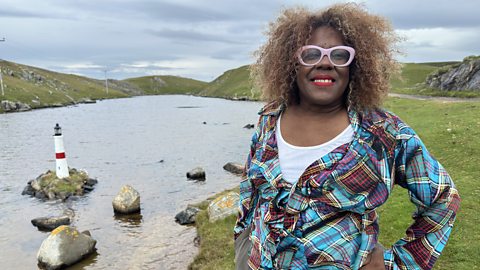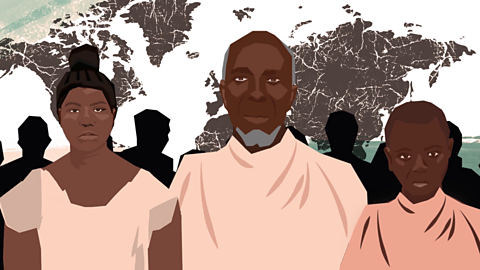Born: 1958
Nationality: Belize-born British
Period: 21st Century
Genre: Orchestral (Spirituals)
Key musical element:
- Texture

About Errollyn Wallen
- Errollyn Wallen was born in Belize and grew up in Britain.
- Before concentrating on composition, Errollyn trained as a dancer in the UK and in America.
- She studied composition at universities in London and Cambridge.
- Her music is very well travelled – a CD of her music was taken into space by an astronaut on NASA mission STS-115. It travelled nearly 5 million miles by orbiting the Earth 186 times!
- Errollyn is in the ‘Top 20 Most Performed Living Composers’ and her music has appeared at many prestigious events. She was the first black female composer to feature in the BBC Proms and wrote music for the Paralympic Games 2012, the Queen’s Golden and Diamond jubilees and the global climate change conference COP 26.
- Errollyn founded the group ‘Orchestra X’ whose motto is “we don’t break down barriers in music… we don’t see any”.
- Errollyn was awarded an MBE in 2007 in the Queen’s Birthday Honours and a CBE in 2020 in the New Year Honours, for services to music.
- In 2024 Errollyn Wallen was appointed Master of the King's Music, a post created in 1626 by King Charles I.
About Mighty River
- Mighty River was written in 2017 to mark the bicentenary of the Abolition of the Slave Trade Act.
- The piece explores the themes of slavery and freedom through the idea of a 'mighty river' - a natural, unstoppable force heading for the ocean, just like the innate human desire to be free.
- Mighty River is in one single movement with no breaks in the music. It flows, like water, from one idea to another.
- Errollyn Wallen has included well-known hymn Amazing Grace, and spirituals Deep River and Go Down Moses in the piece. These melodies were first introduced to the UK by former slaves over 150 years ago.
Listen out for:
- At the beginning the horn is an evocative solo voice playing the well-known hymn Amazing Grace.
- This warm brass sound moves to the piccolo before being passed to the clarinet, double bass and then harp.
- Can you hear how all these instruments have a different sound?
- At the beginning, each instrument is prominent, but then gradually, they begin to add layers to the sound.
- As you watch the clip, notice how all the sections of the orchestra join together, (wind, strings, brass and percussion).
- You can still hear snippets of Amazing Grace but now it is supported by the strength of the orchestra.
- Can you hear where the orchestra takes a step back again and the texture thins, leaving only the solo horn and the djembe drum playing together before the whole orchestra joins them to finish.
Watch the films
YolanDa Brown explores with Errolyn Wallen the themes, rhythms and textures of her piece Mighty River which commemorates the abolition of slavery at her home in the highlands of Scotland
YolanDa:
Just a few hundred years ago, people from Africa were captured, sold and taken in ships to the Caribbean and different parts of America. They were enslaved - kept as prisoners and forced to work incredibly hard without being paid.
Now we can all find things unfair sometimes; if we're not allowed to hang out with our friends all the time or have to do homework that we don't enjoy. But just think, if your entire life was controlled by someone else and all choice was taken away. It's almost impossible to imagine, isn't it?
The slave trade was abolished through an Act of Parliament in 1807. 200 years later, the composer Errollyn Wallen wrote her piece, Mighty River, to mark this significant moment in history.
Enslaved people were forcibly moved around the world on ships sailing over the water. Errollyn Wallen’s piece contrasts the free-flowing movement of the water with the people sailing on it who were not free at all.
The piece begins with a solo horn playing Amazing Grace. A piccolo and then clarinet join the horn to play the melody.
Soon we hear the theme of constantly moving water, flowing and bubbling through the different instruments of the orchestra, with a background of a repeated rhythm, or ostinato, played by the strings. Through the flowing water we can hear bursts of the Amazing Grace melody.
But there is a hint of something else going on underneath. Do you hear it? Do you think it sounds friendly? Hopeful? Or do you think it seems a bit sinister?
Well, the lower instruments in the orchestra - bass trombone, cello and double bass, along with the timpani, play threatening sounding notes underneath the hopeful, constant moving river above. It's a real clash of feelings.
But could hope and freedom be in sight? The Amazing Grace melody is played again by a solo horn at the end of Mighty River, but this time it sounds slightly different.
The composer has suggested that this time it's played freely. The melody now also features an African talking drum, which is an instrument used by the enslaved people to communicate with each other.
The whole orchestra close the piece by playing a chord all together. Do you think it sounds like something's changed?
Now, as a composer, you've chosen a beautiful place to live and write your music. Where are we?
Errollyn:
Living by water is what I seem to have done for most of my life. And I, when I moved to Strathy Point, it really revolutionised how I worked - to be on top of the Atlantic. Being in this particular place has really, really, I don't know, changed my whole sense of being in the world.
Being such a vast landscape makes me feel small and makes composing somehow even an increased pleasure. And it's so quiet here, but at the same time majestic. And I would say also water, from the beginning of composing, it's something I think a lot about.
YolanDa:
Tell me a bit about Mighty River and the inspiration behind this extraordinary piece.
Errollyn:
I wanted to write a work that celebrates the human spirit through suffering and endurance.
The piece is about the journey to freedom.
YolanDa:
And how did your musical ideas grow from what you knew about the transatlantic slave trade?
Errollyn:
How do I represent freedom in music? I thought of water. The way water - a river, a stream will always want to run towards the sea. And I suppose human beings, we have this innate instinct to be free.
It's about freedom and I use water to sort of, sort of almost pictorially represent that.
When you listen to the work, you will hear all these flourishes in the wind, harp solos. And there's a lot of, sort of quite virtuosic stuff, but to me the background movement of how the rhythm works and is relentless, I worked possibly hardest on that.
It's got lightness in it, but it's also got this darkness.
There's one moment where the djembe, which is an African drum, talks to the horn. I always think of it as if, you know, a European talking to an African. And there's this, there's this talking and trying to understand and communicate.
YolanDa:
How does freedom factor into this piece?
Errollyn:
Why I like being a composer is that I feel very free. But freedom takes so many different forms. And in the case of Mighty River, there's this journey, which is a difficult journey, but you do feel the sense of moving through different stages. And then at the end, I hope you feel the sense – ah, we are now out into calm sea.
Gwyliwch Cerddorfa Cyngerdd y BBC’n perfformio Mighty River (byrhau), a’u harwain gan Ellie Slorach
Classroom resources
Lesson plan (KS2/2nd level/Progression Step 3)
Download the lesson plan for four weeks of learning and activities for Mighty River (PDF)

Powerpoint slides (KS2/2nd Level/Progression Step 3)
Download the Powerpoint slides for four weeks of learning and activities for Mighty River (PPT)

KS3 / Third and Fourth Level, S1-3 Independent Lesson Worksheet
Download this worksheet for secondary level cover lesson activity to be completed alongside the intro and performance films - Mighty River (PDF)

Upload and showcase your creative responses
Upload your creative responses to the BBC Ten Pieces Showcase

Explore more about the transatlantic slave trade
Bitesize: the transatlantic slave trade
A Bitesize guide on the transatlantic slave trade for KS3 students, which might provide useful context for teachers for showing the film in class.

